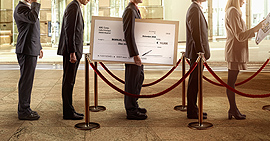Paying by cheque
Check that the terms and conditions of your account allow you to write cheques if you intend to use them. Current accounts usually allow for cheques, but savings accounts normally do not.
Place of payment
A cheque ought to state the place of payment. If this information is omitted, it is assumed to be the place written next to the drawee's name. Only the stated branch is obliged to encash the cheque
Cashing a cheque at a branch other than where the drawer holds his or her account implies the risk that the signature may not be verified. The signature is an essential security feature, preventing fraudulent or irregular payments.
However, it is usually possible to cash a cheque at any branch, as modern technology makes it possible to make the necessary checks with the drawee branch (verifying the account balance, signature, etc.), although a fee is usually charged.
If the customer’s bank account has sufficient funds, the drawee (i.e. the bank) is obliged to pay the stated amount in whole or in part. Cheques issued for payment in Spain must be presented for encashment within 15 days.
Cheque issuance fee
Your bank may charge a fee for issuing a cheque, even if your account is commission-free. It's advisable to check beforehand how much you may be charged.
Once you have the cheque, you can either cash it (as a bearer cheque) or endorse it to somebody else (as an order cheque).
Your bank will debit your account as soon as it has received the cheque from the bank where it was deposited, or on the same day if it was cashed at the branch where you have your account.
Banks may ask customers presenting cheques of any type and amount to identify themselves. This information will be treated as confidential.
Find out more about paying by cheque in our 2020 Complaints Report (in Spanish) (120 KB)
FREQUENTLY ASKED QUESTIONS
Do cheques expire?
Read answeraboutDo cheques expire?
How long does it take for a cheque to clear
Read answeraboutHow long does it take for a cheque to clear



